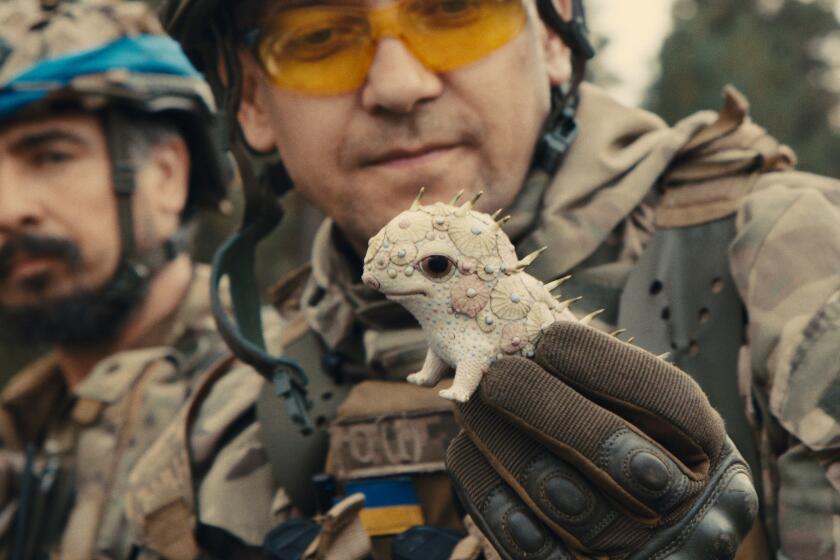‘Red Line’: A Distant Epic
- Share via
For months and even years after World War II officially ended, gaunt, sepulchral figures would periodically emerge from the jungles of some South Pacific island--isolated Japanese soldiers who either hadn’t known the fighting was over or who so believed in their cause they didn’t really care.
Similarly, “The Thin Red Line,” adapted from James Jones’ novel about the bloody 1942 battle for the Japanese-held island of Guadalcanal, is a film out of time. Its writer and director, Terrence Malick, has not had anything on screen since “Days of Heaven” in 1978. Time has stood still for him, as it did for those Japanese soldiers, and for better or worse, he has made something that has more in common with his own personal and delicate last film than anything out there today.
For though it has a reported 60 speaking parts, a 213-page script and a cost estimated at $50 million, “The Thin Red Line” is an art film to the core. If it’s an epic (and at two hours and 50 minutes it certainly has the length) it’s an intimate, dream-time epic, an elliptical, episodic film, dependent on images and reveries, that treats war as the ultimate nightmare, the one you just cannot awaken from no matter how hard you try.
Working with cinematographer John Toll, Malick has retained his eye for crystalline images, and a facility for camera movement so fluid as to seem almost thought-activated. And, from its unnerving opening look at a crocodile floating half above and half below a surface of green slime, “Thin Red Line” has a tendency toward shots that might be metaphorical but then again might not.
At times an almost hallucinogenic surrealism marks the film’s slant on combat, a point of view that bookends nicely with “Saving Private Ryan’s” frank and effective straightforwardness. It’s the sense of being lost and without bearings that Malick emphasizes, the mind-distorting meaninglessness, the awful loneliness and absolute terror of battle. “War doesn’t ennoble men, it turns them into dogs,” one character says. “It makes them small, mean, ferocious; it poisons the soul.”
But while this kind of moody, personal filmmaking can be impressive from moment to moment, it tends to wear thin over nearly three hours. So, hand in hand with its evocative sequences, “Thin Red Line” (the title comes from Jones’ image of the line between sane and mad) can feel precious, self-conscious and even self-indulgent. Poetic almost to excess, it keeps a distance from us, holding its emotions apart, as things best studied at a great and philosophical remove.
This situation results from Malick’s lack of sustained interest in conventional narrative. “The Thin Red Line” is a story told in fragments and shards, in glimpses of action. The film’s concerns are philosophical rather than dramatic, and its extensive voice-over deals not with story points but with ruminations about how to be a man in a world described as “blowing itself to hell as fast as anyone can arrange it.”
“This great evil, where does it come from, how did it steal into the world?” is a typical rumination; “How did we lose the good that was given us?” is another.
Much of this voice-over is spoken by two soldiers, Pvt. Witt (Jim Caviezel) and Pvt. Bell (Ben Chaplin of “The Truth About Cats & Dogs”) and it’s indicative of a wider lack of concern with coherence that both men have such similar Southern accents and dark good looks that it’s anyone’s guess at certain moments which one is speaking.
The film starts with a bucolic interlude; Witt has gone AWOL among the peaceful Melanesians of the Solomon Islands, where the simple pleasures of this unspoiled Eden are contrasted, not for the first time, with the horrors created by nominally more advanced civilizations.
At some point (you won’t know exactly when unless you pay close attention) the voice-over is picked up by Bell, who is not worried so much about the morality of conflict but rather whether his wife (Miranda Otto)--glimpsed in a series of wistful flashbacks--can stand the strain of the prolonged physical separation mandated by the war.
Both Witt and Bell are members of an Army rifle unit, C-for-Charlie Company, that is the film’s group protagonist. “The Thin Red Line” focuses most as a film when these men have to focus most as a combat force, taking part in a suicidal frontal attack on hill 210, a gentle rise fortified by entrenched Japanese machine gun nests.
The resulting action leads to fine specific moments from a group of familiar faces. These include Sean Penn as a first sergeant who’s seen it all, John Cusack as a heroic young captain, Woody Harrelson as a sergeant in extremis, Elias Koteas as a captain who desperately wants to keep his men alive and, in the film’s best performance, Nick Nolte as a lieutenant colonel who for the sake of his own career just as desperately wants to capture that hill no matter what the cost.
But while these actors and others have individual scenes that will look great on a lifetime achievement clip roll (the muscles on Nolte’s neck vibrate as if they’re computer-enhanced when he gets angry), they remain isolated instances. The film is too diffuse to connect up in any meaningful way.
There are also actors whose parts are barely cameo-sized, like George Clooney as a captain who doesn’t even show up until the last few minutes, and an unbilled and uncomfortable John Travolta as a general. Unluckiest of all are those men (Adrien Brody, John C. Reilly, Arie Verbveen, Dash Mihok, John Savage, David Harrod, Jared Leto) with roles so underdeveloped or so murkily introduced we have no idea who they are. One-line descriptions in the press kit tells you more about these soldiers than anything they do on screen, and it’s indicative of something that actress Otto, whose name isn’t even in the press kit, has as much if not more screen time than some of the featured folks.
It’s been reported that Malick shot close to a million feet of film, several times the norm for a feature, and it’s likely that a longer, more illuminating cut of “Thin Red Line” at one time existed. As it stands now, this truncated-feeling film will make the most sense to those who are privy to that extended version. Though there are moments to cherish throughout, “The Thin Red Line” remains a stubbornly personal film, an artwork that only one person will understand and appreciate completely. No one need ask who that person might be.
* MPAA rating: R for realistic war violence and language. Times guidelines: considerable battlefield carnage, including scenes of booby-trapped and mutilated corpses.
‘The Thin Red Line’
Sean Penn: 1st Sgt. Welsh
Adrien Brody: Cpl. Fife
Jim Caviezel: Pvt. Witt
Ben Chaplin: Pvt. Bell
George Clooney: Capt. Bosche
John Cusack: Capt. Gaff
Woody Harrelson: S/Sergeant Keck
Elias Koteas: Capt. Staros
Nick Nolte: Lt. Col. Tall
John C. Reilly: Mess Sgt. Storm
A Fox 2000 Pictures presentation, from Phoenix Pictures, in association with George Stevens Jr., of a Geisler-Roberdeau production, released by 20th Century Fox. Director Terrence Malick. Producers Robert Michael Geisler, John Roberdeau, Grant Hill. Executive producer George Stevens Jr. Screenplay by Terrence Malick, based on the novel by James Jones. Cinematographer John Toll. Editors Billy Weber, Leslie Jones, Saar Klein. Costumes Margot Wilson. Music Hans Zimmer. Production design Jack Fisk. Running time: 2 hours, 50 minutes.
Mann Village, 961 Broxton Ave., Westwood Village, (310) 248-MANN, Ext. #051; opens Friday at Edwards Newport Cinema, 300 Newport Center Drive, Newport Beach, (949) 644-0760.
More to Read
Only good movies
Get the Indie Focus newsletter, Mark Olsen's weekly guide to the world of cinema.
You may occasionally receive promotional content from the Los Angeles Times.











